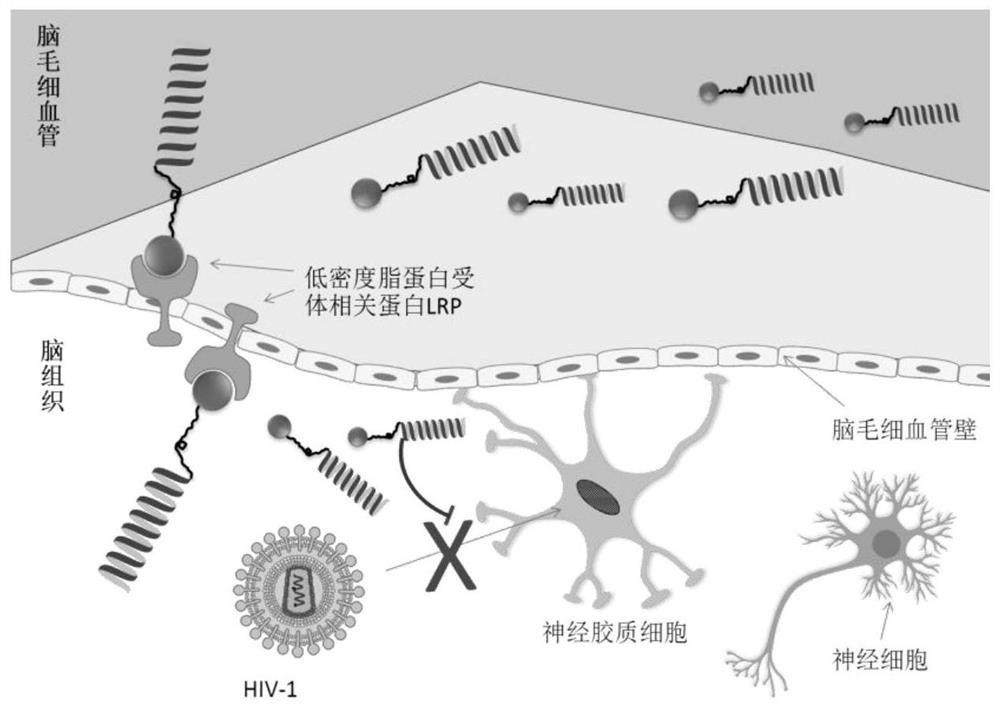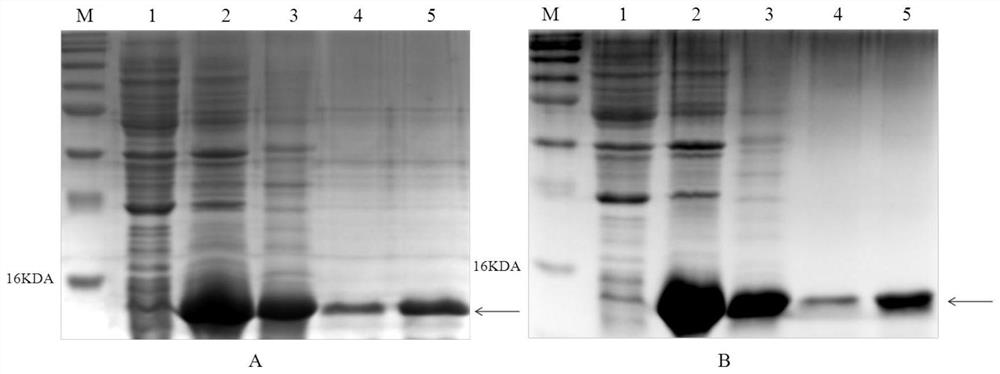Brain-targeted HIV entry inhibitor polypeptide and application thereof
An entry inhibitor and brain-targeted technology, applied in the field of biomedicine, can solve problems such as viral load rebound and inability to effectively prevent HIV infection, and achieve low toxicity and strong specificity
- Summary
- Abstract
- Description
- Claims
- Application Information
AI Technical Summary
Problems solved by technology
Method used
Image
Examples
Embodiment 1
[0042] Example 1AL 6 T, TL 6 Expression and purification of A
[0043] 1. Construction of recombinant plasmids
[0044] Construction of protein expression plasmids pET-28a-Ang-L6-T1144 and pET-28a-T1144-L6-Ang, Ang-L6-T1144 and T1144-L6-Ang nucleotide sequences were synthesized by Suzhou Jinweizhi Biotechnology Co., Ltd. and approved BamHI and EcoRI were inserted into pET-28a expression vector.
[0045] Wherein, the Ang-L6-T1144 nucleotide sequence is as follows:
[0046] CGGATCC ATGACCTTTTTTTTATGGCGGCTGCCGCGGCAAACGCAACAACTTTTAAAACCGAAGAATAGCGGCGGCCGCGGCGGCACGACCTGGGAAGCATGGGACAGAGCTATTGCTGAATACGCAGCTAGGATAGAAGCTTTACTCAGAGCTTTACAAGAACAGCAAGAAAAGAATGAAGCAGCCTTAAGGGAATTA CACCACCACCACCACCACTAA GAATTC ; Wherein the underlined part contains the enzyme cleavage site and 6*his purification tag, the non-underlined part is the codon sequence of SEQ ID NO.3, the non-underlined part refers to SEQ ID NO.5, and the italicized part is the promoter.
[0047] The nucleotide sequence...
Embodiment 2HI
[0063] Example 2 Construction of HIV cell-cell fusion detection model
[0064] Studies have shown that the method of detecting HIV fusion inhibitors through cell-cell fusion models and pseudovirus models is feasible (reference 1: Li Jianbin, Chen Bin, Mi Zhiqiang, et al. Construction of human immunodeficiency virus pseudovirus drug screening model and Its application [J]. Biotechnology Communications. 2012,23(04):481-484. Reference 2: Wang Ping, Chen Huan, Luo Ronghua, et al. VSVG / HIV-1_(NL4-3)Luc Pseudovirus Screening Condition optimization and application of anti-HIV-1 drugs [J]. Chinese Pharmacology Bulletin. 2016, 32 (03): 433-438), compared with other detection models, the construction speed of these two models is fast, and it is very important for the laboratory The level requirements are low, and general laboratories can perform related experiments, and can evaluate the inhibitory effect of drugs on virus entry into cells.
[0065] Based on this, we constructed a cell-...
Embodiment 3
[0087] Example 3 The polypeptide has anti-HIV cell-cell fusion activity
[0088] References for inhibition of cell fusion experiments (Reference 4: Alam M M, Kuwata T, Tanaka K, et al.Synergistic inhibition of cell-to-cell HIV-1 infection by combinations of single chain variable fragments and fusion inhibitors[J].BiochemBiophysRep.2019 , 20:100687). Proceed as follows:
[0089] (1) On the first night, the pre-plated 293T cells were made into a cell suspension and plated in a 6-well plate.
[0090] (2) The next day, after the cells were cultured overnight and the density reached about 70-80%, transfection was performed. The pAAV-IRES-EGFP plasmid was transfected into 293T cells as a negative control, and the pAAV-EGFP-SC42 plasmid was transfected into Another well was used for fusion experiments.
[0091] (3) 12-18 hours after transfection, replace with fresh medium.
[0092] (4) On the fourth day, the cells transfected for 48 hours were observed for transfection efficiency...
PUM
 Login to View More
Login to View More Abstract
Description
Claims
Application Information
 Login to View More
Login to View More - Generate Ideas
- Intellectual Property
- Life Sciences
- Materials
- Tech Scout
- Unparalleled Data Quality
- Higher Quality Content
- 60% Fewer Hallucinations
Browse by: Latest US Patents, China's latest patents, Technical Efficacy Thesaurus, Application Domain, Technology Topic, Popular Technical Reports.
© 2025 PatSnap. All rights reserved.Legal|Privacy policy|Modern Slavery Act Transparency Statement|Sitemap|About US| Contact US: help@patsnap.com



